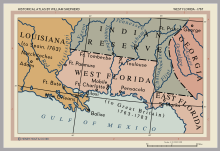Our website is made possible by displaying online advertisements to our visitors.
Please consider supporting us by disabling your ad blocker.
West Florida
| West Florida | |||||||||||||||||
|---|---|---|---|---|---|---|---|---|---|---|---|---|---|---|---|---|---|
| Territory of Great Britain (1763–1783), Spain (1783–1821). Areas disputed between Spain and United States from 1783–1795 and 1803–1821. | |||||||||||||||||
| 1763–1821 | |||||||||||||||||
 British West Florida in 1767 | |||||||||||||||||
 Digital map of West Florida in 1767 | |||||||||||||||||
| Capital | Pensacola | ||||||||||||||||
| Government | |||||||||||||||||
| Governor | |||||||||||||||||
• 1763–1783 | 5 under Britain | ||||||||||||||||
• 1783–1821 | 10 under Spain | ||||||||||||||||
| History | |||||||||||||||||
| 10 February 1763 | |||||||||||||||||
| November 25, 1783 | |||||||||||||||||
| 1795 | |||||||||||||||||
| 1800 | |||||||||||||||||
| 1810 | |||||||||||||||||
• Annexation by U.S. | 1810 | ||||||||||||||||
| 22 February 1821 | |||||||||||||||||
| |||||||||||||||||
West Florida (Spanish: Florida Occidental) was a region on the northern coast of the Gulf of Mexico that underwent several boundary and sovereignty changes during its history. As its name suggests, it was formed out of the western part of former Spanish Florida (East Florida formed the eastern part, with the Apalachicola River as the border), along with lands taken from French Louisiana; Pensacola became West Florida's capital. The colony included about two thirds of what is now the Florida Panhandle, as well as parts of the modern U.S. states of Louisiana, Mississippi, and Alabama.
Great Britain established West and East Florida in 1763 out of land acquired from France and Spain after the Seven Years' War. As the newly acquired territory was too large to govern from one administrative center, the British divided it into two new colonies separated by the Apalachicola River. British West Florida included the part of formerly Spanish Florida, which lay west of the Apalachicola, as well as parts of formerly French Louisiana; its government was based in Pensacola. West Florida thus encompassed all territory between the Mississippi and Apalachicola Rivers, with a northern boundary which shifted several times over the subsequent years.
Both West and East Florida remained loyal to the British crown during the American Revolution, and served as havens for Tories fleeing from the Thirteen Colonies. Spain invaded West Florida and captured Pensacola in 1781, and after the war Britain ceded both Floridas to Spain. However, the lack of defined boundaries led to a series of border disputes between Spanish West Florida and the fledgling United States known as the West Florida Controversy.
Because of disagreements with the Spanish government, American and English settlers between the Mississippi and Perdido rivers declared that area as the independent Republic of West Florida in 1810. No part of that short-lived republic lay within the borders of the modern U.S. state of Florida; rather, it comprised the Florida parishes of today's Louisiana. Within months it was annexed by the United States, which claimed the region as part of the Louisiana Purchase of 1803. In 1819, the United States negotiated the purchase of the remainder of West Florida and all of East Florida in the Adams–Onís Treaty, and in 1822 both were merged into the Florida Territory.
Previous Page Next Page




